











RETAILERS PUT AI TO WORK















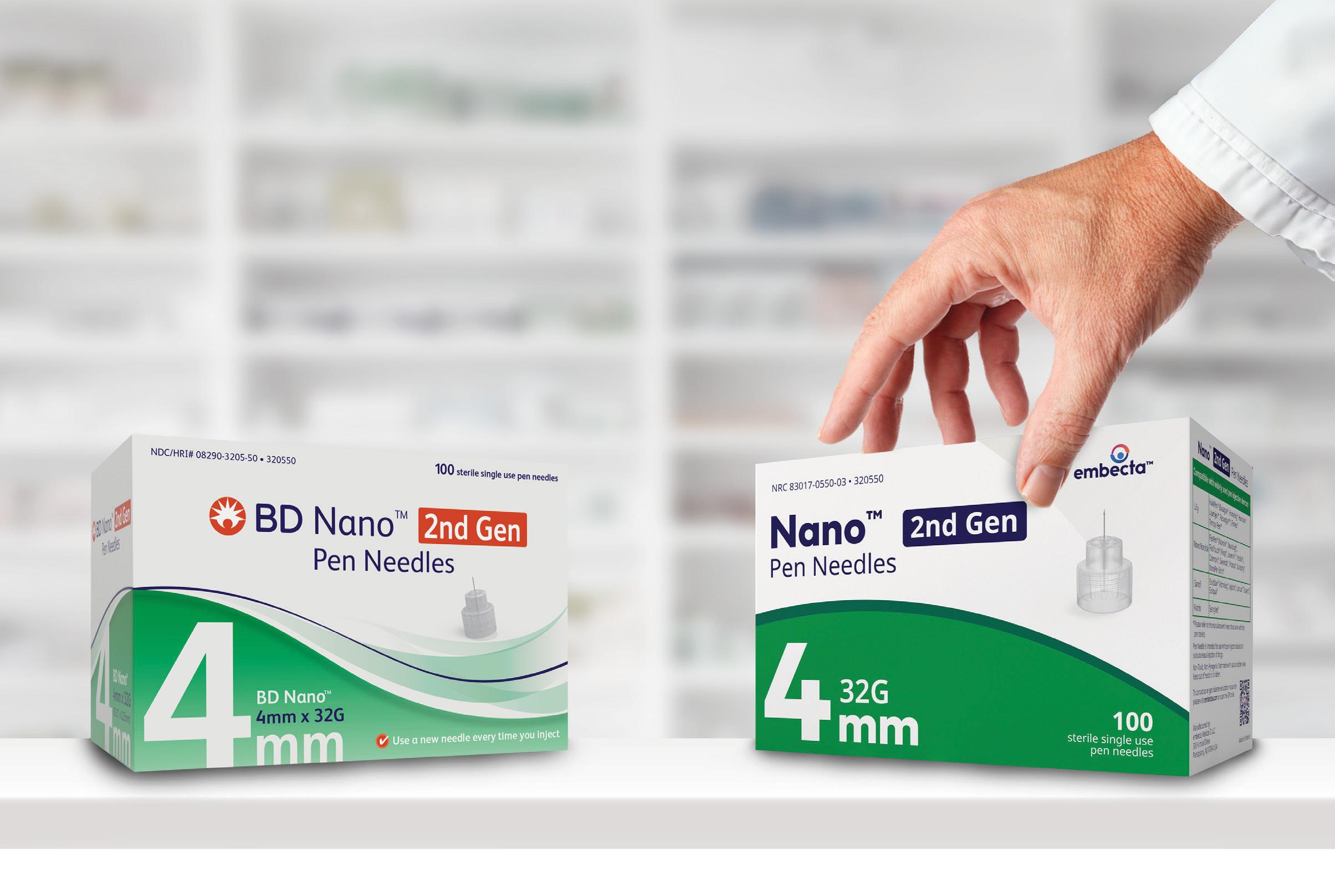




Facebook.com/DrugStoreNews
linkedin.com/company/drug-store-news/ instagram.com/dsn_media
Skin care, hair strength and fragrances are all categories seeing an uptick in sales as Americans flock to weight loss drugs
Supermarket pharmacies are doubling down on healthcare access and food-as-medicine initiatives
Consumers value efficacy, innovation and convenience when it comes to eye- and ear-care
Despite a post-COVID sales falloff, the market has promising segments, including propolis, mushrooms and lollipops









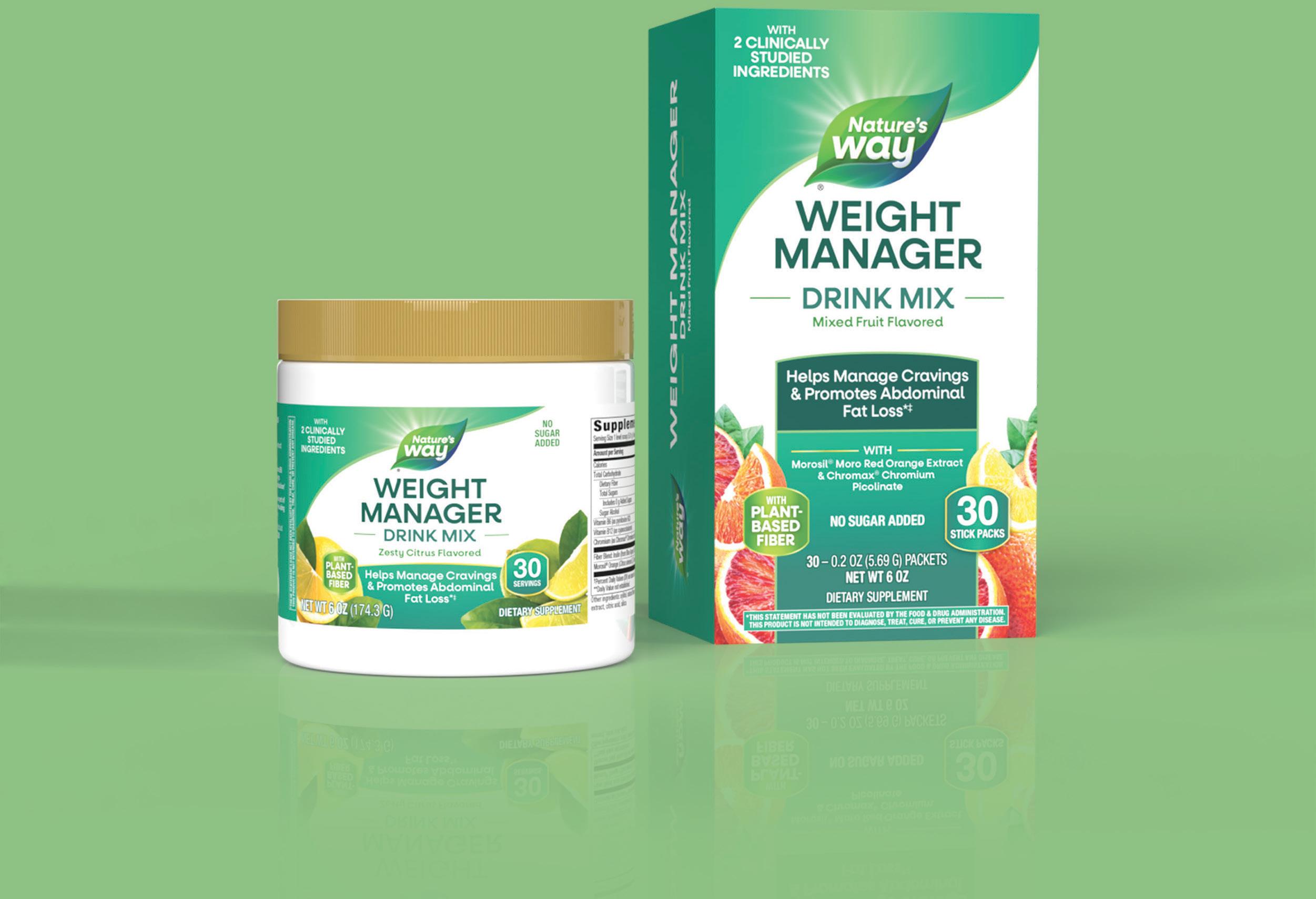
Weight Manager is a delicious NEW daily drink mix with two clinically studied ingredients that help:
• Promote abdominal fat loss*‡
• Manage cravings*‡
• Support blood sugar metabolism* discover a new
HRG’s five notable products from April 2 4 1 3 5

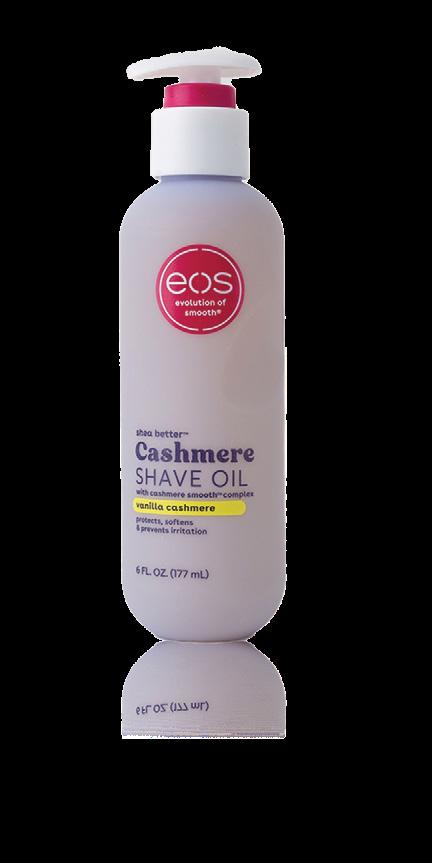

Product introductions remained robust in April (after seeing a surge in March), despite volatility in the stock market and an ongoing trade war.
In March, suppliers introduced 197 new products, two more items than they released in February. Waukesha, Wis.-based HRG reviewed 24 products in the health category, 149 items in the wellness sector and 24 products in the beauty aisle to see which ones stood out as Products to Watch:
Procter & Gamble said its Metamucil Supergreens Digestive Blend helps promote plant-powered regularity as well as gut health. It also contains soluble corn fiber, kale, spirulina, broccoli and spinach. The product is gluten-free, contains no added artificial dyes and is sweetened with plant-based Stevia, the company said. It comes in a 5.5-oz. container.
Shea Butter Cashmere Shave Oil Serum from eos Products hydrates like an oil, with the feel of a serum. The company said the product conditions with deep, penetrating, barrier replenishing moisture that protects and strengthens skin’s moisture barrier and repairs dry skin. The serum comes in a 6-oz. bottle.


The Bee Clean Hand Sanitizer is a 100% organic beeswax product that comes in a pocket spray. The brand states that the product kills 99.9% of germs and protects hands using beeswax, vitamin E, avocado oil and apricot seed oils. The .67-oz. bottle contains 200 sprays.
Lipo Flavonoid Ear Pain Relief Drops by Bridges Consumer Products provides fast acting pain relief with 4% lidocaine to soothe and calm ear pain and discomfort, the company said. It relieves aggravated nerves and provides numbing relief from aching, throbbing and ear pain. The product is anti-bacterial to fight against ear infection and has a drying agent to reduce the clogged feeling from swimmer’s ear. It comes in a .42-oz. bottle.
Combe’s Vagisil Probiotic Mousse Wash is designed for menopausal women, and features probiotic ingredients for maximum benefit. The sulfate-free foaming cleanser is gentle and pH balanced to 5.5 to support the mature microbiome. It provides all-day freshness and up to 24-hour odor protection. It comes in a 6-oz. bottle. dsn
The retailer is improving outcomes across the Midwest by expanding its clinical services and growing its specialty and long-term care operations
By Sandra Levy

What does it take for a 141-year-old regional pharmacy to succeed in today’s challenging operating environment for pharmacies?
Just look at employee-owned Thrifty White Pharmacy, which has nearly 100 pharmacies located throughout Minnesota, North Dakota, South Dakota, Iowa, Montana and Wisconsin. From investing in technology to growing its specialty pharmacy division, serving long-term care patients and positioning itself as a key partner to patients, payers, providers and health systems, Thrifty White has left no stone unturned in its efforts to provide high-quality care while enabling its pharmacists to practice at the top of their license.
Drug Store News visited Thrifty White in Fargo, N.D., and witnessed the full range of innovations driving patient care.
The company’s strength, according to Justin Heiser, president and CEO, lies in its employee-owners. “Being 100% employeeowned has played a key role in our success,” Heiser said. “Our teams are deeply committed to our mission and the rural communities we serve. Their ownership mindset and willingness to adapt have been essential to our continued growth.”
Pointing out that in many of the communities it serves, patients may not have accessible healthcare options, Heiser said, “Thrifty White has become the access point for care. We built a lot of our services to enable access, and we partner with local systems and providers to extend that care into the communities we serve.”
Tanya Schmidt, vice president of central operations, echoed Heiser’s sentiments. “In those rural communities, we have the pharmacy set up to take care of our patients. If we didn’t have a pharmacy there, they might have to drive 50 to 100 miles to get their medications. We want to make sure they have access to medications—and to our pharmacists.”
Beyond improving access, Thrifty White has invested in a technology-driven 45,000 sq. ft. central fill facility in Fargo. Shifting dispensing to this location frees up local teams to focus on clinical services and deeper engagement with patients.
“A lot of the foundation we’ve built over the years has been focused on leveraging technology to enable us to get beyond pharmacy,” said Jeremy Faulks, vice president of pharmacy operations.
“We’re a complex pharmacy operation managing community, long-term care and specialty pharmacy patients in pharmacies across six states. We maintain our own dispensing system and IT department, allowing us to streamline this operation and leverage technology to drive efficiencies, which simplify the fulfillment work of the local pharmacies. This enables Thrifty White to offer more clinical services and gives pharmacists more time to engage with patients.”
Faulks noted that with central fill taking on some of the dispensing workload, pharmacists have more time to focus on clinical care—like identifying and closing vaccination gaps, offering point-of-care testing and delivering MTM services.
“It’s about using that time to meet patients where they are and help them stay on track,” he said. “That’s where we see the future of pharmacy. It’s around delivering those clinical services, engaging with patients and using that prescription as a starting point to the relationship—then focusing on everything else we can do to help them have better outcomes because they are coming to our pharmacy.”
The investment in technology also has helped Thrifty White’s pharmacists practice at the top of their license. “The pharmacists are highly clinically trained, and they don’t want to go back to ‘count, stick and pour,’” Schmidt said. “We’ve invested in central fill to free up their time so they can do more of those clinical interventions that make a real difference in our patients’ lives and health outcomes.”
Cassie Doyle, vice president of clinical and business transformation, said that many of the company’s pharmacists and technicians grew up in the towns where Thrifty White operates, so they understand the needs of the community.
“That has been a big differentiator for us in rural markets. Our teams know our patients,” Doyle said.
Aside from investing in technology, forging partnerships with providers, health systems and payers has become the cornerstone of Thrifty White’s success, not only in expanding clinical services and patient engagement but also in being


reimbursed for many of those services.
“One of the barriers has been that pharmacists don’t have provider status. We can’t bill for some of these services, so we need to leverage partnerships to deliver care while also working on legislation that enables more pharmacist-delivered services,” Faulks said.
Doyle said, “We’ve built strong relationships with regional payers, and as legislation evolves, we’re seeing more opportunities for pharmacists to deliver direct patient care.”
The progress is incremental, but it’s happening. Recent changes across Medicaid, commercial and Medicare plans are critical steps toward allowing us to provide more consistent, high-quality care.”
With 1 out of 3 Americans lacking access to a primary care provider, Thrifty White has put resources in place to help patients, health plans and local health systems.
“Through these collaborations, there is a strong focus on preventive health for patients who may be overdue for services like vaccines, eye exams or colorectal screenings. We continue to work directly with payers and health systems, identifying opportunities to further support their value-based care goals,” Doyle said.
Heiser added, “As our relationships with regional payers have grown, value-based care has become a natural area of alignment. At the end of the day, we’re all focused on measuring quality and improving patient outcomes and that focus ultimately helps drive down the overall cost of care.”
To that end, Thrifty White also is focused on making it easier for patients to engage with their pharmacists.
Thrifty White’s care-focused store design puts pharmacists front and center with an Ask the Pharmacist station near the pharmacy counter and a private consultation room nearby. Many locations also include clinical exam suites that create


Essentials, an e-commerce platform designed to support evolving consumer needs.
Faulks explained, “As we downsize the front end and sell fewer OTCs to make space for clinical suites, we wanted to make sure we still make products available. Health Essentials is our e-commerce offering that allows patients to extend the aisle. If they want a different bottle size or a product we can’t carry in-store, they can order online and ship it to their home. It’s a standalone business that integrates into our core offering, providing a hybrid experience between pure e-commerce and what retail can offer.”
Thrifty White also has taken steps to improve efficiency in medication sourcing, including the buildout of a new NABP Drug Distributor Accredited warehouse to support direct manufacturer relationships. “It’s a key part of ensuring we source medications responsibly and efficiently,” Faulks said. “We work directly with more than 100 suppliers for both brands and generics, bringing products into our warehouse and self-distributing to our pharmacies and affiliate partners. We go direct where it makes sense, while still maintaining flexibility with our wholesaler and distributor partners.”
Thrifty White also has invested in the development of Patientricity, a pharmacy platform that integrates clinical services directly into the dispensing workflow.
“Rather than having pharmacists toggle between systems and jump across platforms, it’s all happening in one place,” Faulks explained. “They’re in queue, doing their dispensing work, and clinical interventions pop up so they can take the time to engage
with a patient or schedule a follow-up. We can even trigger interventions automatically based on data fed into our systems and specific clinical criteria.”
The system is integrated with state vaccine registries, enabling Thrifty White’s pharmacists to identify patients with immunization gaps. “It allows us to create meaningful opportunities for engagement, so the next time a patient is in the pharmacy, we can say, ‘You’re overdue for your shingles or pneumonia vaccine,’” Faulks said. “That kind of flexibility continues to be incredibly important as we work with health plans to close gaps in care and improve outcomes.”
So, what does the future look like?
“There’s so much more we can do in our footprint,” Heiser said. “We’re doubling down in the communities we already serve and growing into new ones where we can make a difference. Access to high-quality health care remains a challenge, especially in rural communities, and we believe pharmacy can play a key role in closing that gap. Our technology, clinical and physical investments have positioned us to address these needs, and now we’re focused on proving we can be the solution.” dsn

Debor ah Dixon, founder of Precious Mineralz LLC, shares how the brand’s OUT OF MOUNTAINS line blends geology and clean science to deliver sustainable skincare—while giving back to people and pets in need.
Drug Store News: Tell us about Precious Mineralz LLC and how the OUT OF MOUNTAINS brand was created.
Deborah Dixon: The marriage between my husband Spenst Hansen, PhD, and I is not only a marriage in private life, it also is a marriage of our education, expertise and business experience. He is a PhD Geologist, Mining Engineer and has been successful in the mining industry. I earned a PhD in the Life Science area, and have worked at startups, small companies and a Fortune 500 company that develop and commercialize medical devices and diagnostics, food safety test kits and consumer products in the automotive and beauty industries.
Precious Mineralz LLC is in the Historic Tintic Mining District in Mammoth, Utah. It is privately owned and womanmajority-owned by him and I. We also own and operate Northstar Clay Mines LLC, an open pit mine, where we selectively collect and process Halloysite for use in skincare products. Because Halloysite is mined, we chose OUT OF MOUNTAINS as our trademarked brand. It also pays homage to the rich history of the mining industry in Utah. We say that OUT OF MOUNTAINS is the indie brand that geology built!
DSN: Can you tell us more about Halloysite and why it is so unique? What characteristics does it possess that make skincare products so effective?
DD: Halloysite is nanotubular kaolin clay. Kaolin is used in many cosmetic and skincare products. Structurally, it forms sheets. Due to certain geological conditions, the sheets roll up and form nanotubes. Halloysite is only mined in a handful of places in the world. Due to the nanotube size, they easily penetrate the skin and release key ingredients in a time-release fashion. This has been scientifically proven. Halloysite is considered Generally Regarded as Safe (GRAS) by the FDA and is on the EPA’s Inert Ingredient List. Besides serving as a carrier for key ingredients, including peptides and hyaluronic acid, Halloysite has a MOHS Hardness Scale of 2-2.5. It is mildly abrasive and helps polish skin in exfoliating products. Additionally, it helps with “spreadibility.” It is a fascinating raw material, and we know how to apply it. At Precious Mineralz we say that our products help achieve beauty from the inside out!
DSN: Please share the philosophy behind the products and their formulation.
DD: Rather than introducing many products, we believe in a minimal approach. We offer products that work alone and complement each other. The face products include Rejuvenating
Deborah Dixon owner of Precious Mineralz LLC, and founder of OUT OF MOUNTAINS

Facial Cream Cleanser, Renewing Face Cream, Under Eye Correction Cream and Protective Lip Balm. The body products include Restorative Hand and Body Cream, Soothing Cuticle Balm, and Rich Body Polish. In addition, we offer Eyelash Booster and Eyebrow Booster. All products are:
• Clean – products are parabens free, talc free, phthalate free, have no artificial dyes or fragrances
• Sustainable – We formulate with many sustainable ingredients that are natural and upcycled.
• Recyclable Containers – all containers are recyclable
• Vegan – we use no animal derived ingredients
• Cruelty free – no testing is conducted on animals
DSN: What are the company plans beyond the current products?
DD: We will be launching a men’s line this year for skincare and grooming.
DSN: What is Precious Mineralz as a company passionate about? And you personally?
DD: Precious Mineralz is Purpose Driven. Our purpose is to Help Fight Hunger and Homelessness for People and Animals. Our two charitable organizations are Utah Food Bank and Best Friends Animal Society. They receive monetary and in-kind donations from our efforts at the company. We also support the Look Good Feel Better program through our membership at Professional Beauty Association. The program helps women fighting breast cancer.
I am a recreational musher and have had numerous huskies on my team that are rescues. I believe they deserve a second chance, and they show their gratitude for this new chapter. I advocate for those who cannot speak for themselves.















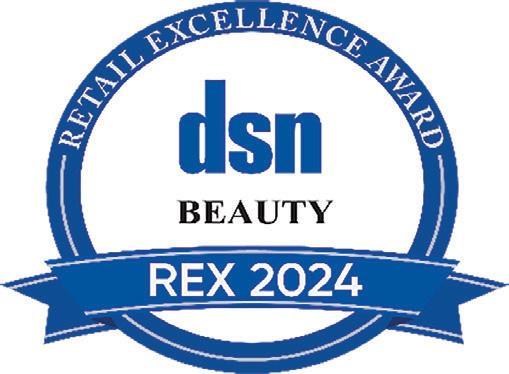

















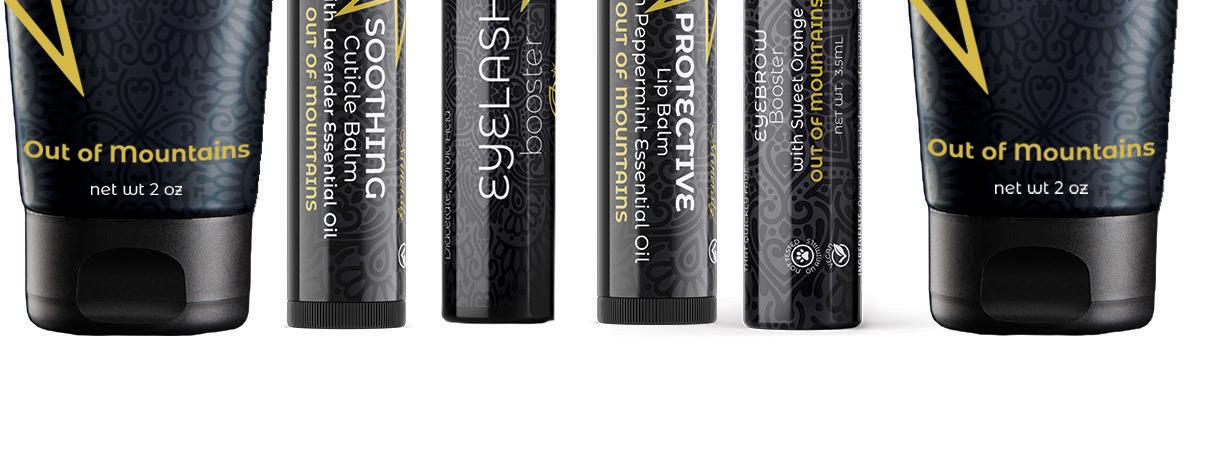












Idaho eliminated detailed regulations, replacing them with just 14 pages of statute, allowing pharmacists to operate within the bounds of their education, training and a generally accepted standard of care. This approach enabled rapid innovation, supported advanced services like independent prescribing, therapeutic substitution, lab test interpretation and vaccine administration. Idaho now even permits technicians to prescribe certain products.
Adams distinguished between legal “scope of practice” and actual “clinical ability,” advocating for recognition of pharmacists’ individual competencies. Adams predicted more U.S. states will adopt this standard-of-care model and stressed the importance of separating scope from payment to encourage service uptake. Though corporate chains often are restricted from expanded scope, states like Idaho serve as a pilot for innovation that could spread nationwide, creating a flywheel effect for broader change, he concluded.
A panel featuring Alex Adams, director of the Idaho Department of Health and Welfare; Justin Bates, CEO of Ontario Pharmacists Association; Allison Bodnar, CEO of Pharmacy Association of Nova Scotia; and Margaret Wing, CEO of Alberta Pharmacists Associations, explored how Canadian provinces have advanced the scope of pharmacy practice and the impact of these changes on healthcare access, system sustainability and patient outcomes. While the journey has varied across provinces like Nova Scotia, Alberta and Ontario, a common theme was the shift from viewing pharmacists as dispensers to fully integrated primary care providers.
In Nova Scotia, pharmacists have led the way in operating clinics that separate clinical services from dispensing workflows, leading to improved efficiency, high patient satisfaction and meaningful reductions in ER visits. The pandemic was a pivotal moment, prompting governments to embrace pharmacist-led care and enabling widespread vaccine delivery. These clinics now operate at near capacity and are tightly integrated into the province’s health systems.
Alberta, a pioneer in full scope authority, experienced early stagnation due to a lack of funding and business models but later secured comprehensive public reimbursement for clinical services. Now, pharmacists provide more than 4 million prescriptions annually, with injections, renewals and minor ailments making up the bulk of services. Alberta serves as a model for sustainable pharmacist-led care. Ontario lags behind but is gaining momentum. Although progress has been incremental, public support, pandemic-era gains and mounting political pressure have advanced services like immunizations and minor ailment prescribing. However, tension with physician organizations and fragmented regulatory frameworks remain challenges.
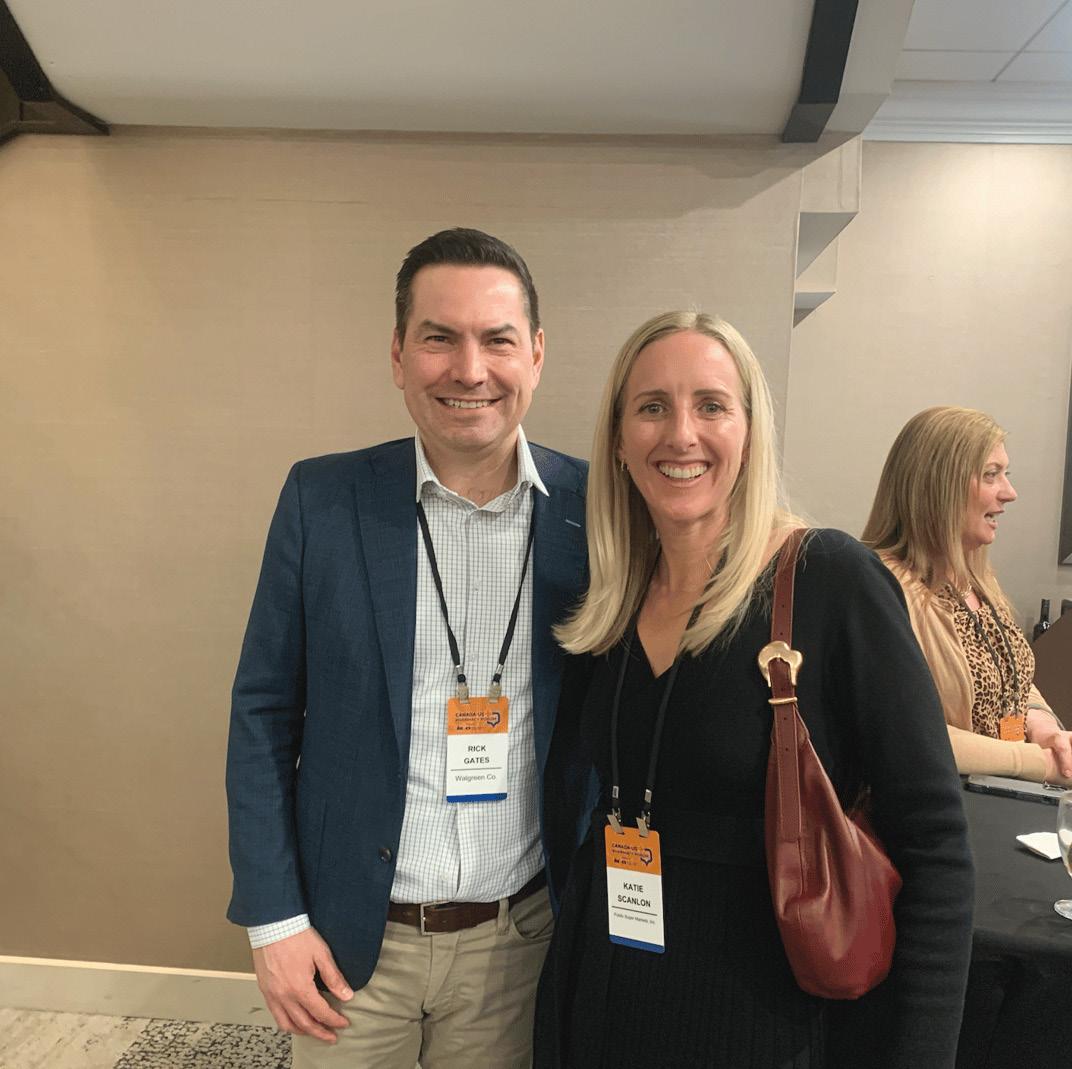
Speakers emphasized the need for harmonized, standard-ofcare models across jurisdictions to ensure pharmacists can fully leverage their training and fill gaps in the healthcare system.
Dave Puri, senior vice president of pharmacy at Shoppers Drug Mart, presented on the expansion of pharmacy-led clinics in response to Canada’s healthcare access crisis. With 6.5 million Canadians lacking a family doctor and increasing strain on emergency departments, Shoppers Drug Mart saw an opportunity for pharmacists to fill a critical care gap. In 2022, they launched their first pharmacy care clinic in a grocery store in Lethbridge, Alberta. The success of that pilot—with lines of patients on day one and national attention—validated the model.
Building on this, they introduced clinics across provinces, like Nova Scotia, and created a new “Care Concierge” role to streamline patient intake and support pharmacists in delivering care. In 2023, Shoppers Drug Mart began integrating these clinics into all new store builds, reimagining pharmacy workflows with enhanced technology and patient-focused layouts.
To scale, they pursued both new store builds and selective renovations, prioritizing areas with favorable reimbursement policies. Key challenges included staffing, training, standardization, and proving clinical quality. Despite these hurdles, they plan to reach 260 clinics nationwide by the end of the year, already having served 1.5 million patients in 2023 alone—positioning pharmacy as a central pillar in accessible Canadian healthcare.
“ The DSN Canada/U.S. Pharmacy Forum presented a unique opportunity to unite pharmacy leaders from both sides of the border in a dynamic and collaborative environment. This forum encouraged participants to share best practices, and explore innovative strategies that will elevate patient care in both countries.

By bringing together experts from diverse healthcare systems, the forum created a platform for problemsolving around shared challenges in pharmacy operations and patient engagement. There were in-depth presentations and conversation about emerging trends, technologies, and regulatory strategies.
The forum also provided networking opportunities that will lead to new partnerships across the North American pharmacy community.
By working together, we can drive meaningful change and enhance the impact of pharmacy in improving health outcomes for all patients.”
– Steve Guyatt, president of MCP, Emerson Canada
“ This session reinforced that building a stronger pharmacy workforce requires cross-sector collaboration among educators, employers, vendors and regulators.

Education reforms are essential to graduate confident, practice-ready professionals by aligning training with the realities of modern pharmacy practice. Once in the workforce, pharmacists need system-level accountability to address burnout and unsafe staffing conditions. Regulatory changes, such as expanding the scope of technicians and streamlining international licensing pathways, will attract new talent and distribute workload across the pharmacy team. Additionally, AI-enabled pharmacy technologies should be leveraged to automate manual tasks, reducing administrative burden and unlocking much-needed capacity across the system.”
– Purya Sarmadi, Co-Founder & Chief Executive Officer, MedMe Health

PBM-owned pharmacies; patient steering to PBM-owned or mail-order pharmacies and restricted pharmacy networks.
Boutte said it has affected patients, too. Patients are often forced to use pharmacies not of their choice and forced to pay more out-of-pocket costs due to PBM rebate manipulation and formulary exclusions. It also has created a major health equity issue, especially in rural and underserved areas.
Her proposed solutions included transparency in contracts, reimbursements and fees; fair reimbursement models with defined minimums; any willing provider participation in networks; prohibited patient steering; accountability government oversight; and passing manufacturer rebates directly to patients.
This panel looked at how advocacy efforts are driving meaningful PBM reform across the United States. It looked at the strategies and tactics that offer actionable approaches that can be adapted to the Canadian market.
The panel, which included Randy McDonough, incoming president of American Pharmacists Association, Summer Williams-Kerley, Rite Aid, and Christie Boutte, NACDS, kicked things off by explaining patient steering–when PBMs direct patients to specific pharmacies by altering
Continue to full story online

Solutions seek to drive efficiencies, boost sales and enhance the customer experience
By Mark Hamstra

Artificial intelligence and machine learning are now firmly embedded throughout the technology systems that businesses use to operate. Retailers are implementing AI-powered solutions in everything from chatbots that help provide customer service to data analytics tools that assist in category management.
In retail pharmacies specifically, analysts expect that AI and machine learning will increasingly be used to automate tasks, such as processing prescriptions and refill requests and analyzing patient data to identify potential drug interactions and dosage errors. Other AI applications could be used to help retailers provide support for medication adherence by generating automated follow-up messages, for example.
In general, retailers are looking at AI as a tool that can be leveraged to increase efficiencies through automation, and to assist in decision-making based on the rapid analysis of extensive datasets.
Chuck Reynolds, managing director and partner in L.E.K. Consulting’s Boston office and a member of the firm’s digital practice, said retailers should be looking at AI beyond its ability to drive efficiencies and enhance customer experiences. While these may drive gains in the short term, they will likely soon become table stakes as other retailers will also rapidly adopt similar AI-driven tools, if they have not already.
Retailers should be looking at how AI can help them leverage the unique assets and customer relationships they have in order to create new opportunities, Reynolds said. He also said retailers need to empower AI platforms to make decisions with humans involved, and within an environment governed by guardrails. Reynolds added that AI was still in the very stages of development, and its potential is still unknown. He likened it to the introduction of mobile phones, which of course have led to sweeping changes in the way consumers and businesses behave and interact with each other.
“When cell phones first came out, no one imagined that you were going to call a car and get into a stranger’s car and drive away,” he said. “It took the amalgamation of many different things coming together.
That’s why it’s important for businesses to become familiar with AI now and increase their understanding of the data needed to optimize it in their organizations. New, unexpected opportunities are sure to arise.
Here are some of the broad, key areas where retailers are expected to have increased opportunities to leverage AI in their operations in the near term:
In addition, synthetic data is also widely used in the creation of the machine-learning models that inform many AI applications. Synthetic data is considered to have several advantages over real data, including the speed at which it can be created and the ease with which it can be scaled up to create massive data sets.
“It is an accelerant for insights organizations within retailers to understand where the market might be going so that they can better merchandise and better market their wares,” said Reynolds.
AI can also use data analytics to troubleshoot challenges that retailers face. A McKinsey report outlined a hypothetic scenario in which a retailer saw an unexpected sales decline in a certain category. Rather than spending time researching the possible causes, an AI system that has been trained on the retailer’s proprietary data could instantly generate a list of potential causes as well as a set of actions the retailer could take to help prevent such sales declines in the future.
The report predicted that gen-AI-powered decision-making systems that perform such functions could drive up to 5% in incremental sales and improve earnings before interest and taxes by 0.2 to 0.4 percentage points.

“Retailers need to understand their business needs, rather than chase AI for AI’s sake, and then find the right tool to help them.”
Data is the lifeblood of AI, and analysts see ongoing opportunities for AI to get more mileage out of retailers’ data. One of the AI applications that may hold potential for retailers is the use of generative AI to create synthetic data, said Reynolds. Synthetic data is created using gen-AI to mimic certain consumer groups, such as a retailer’s target customers, to gauge their response to new products or services, for example. Many customer research organizations—including L.E.K. Consulting itself—are already using this tool to help them better understand consumers, he said.
– John Harmon, managing director of technology research, Coresight Research

The ability of AI to analyze data sets and make decisions is also valuable to retail supply chains.
Inventory management and demand forecasting represent areas where retailers have opportunities to drive cost savings, said Reynolds. AI can help retailers use a wide range of data to optimize inventory levels and calculate and compare procurement terms.
John Harmon, managing director of technology research at Coresight Research, agreed that retailers have opportunities to fine-tune their merchandising and supply chain operations using AI and machine learning.
“Retailers can raise revenues and margins with AI/MLpowered-platforms such as demand forecasting, inventory optimization and price optimization,” he said. “These platforms put the right products on the right shelves at the right time, eliminating out-of-stocks, which boosts customer satisfaction and therefore, revenues.”
Walmart, of course, with one of the world’s most efficient supply chain operations, has been at the forefront of these efforts. Among a host of other AI initiatives, the Bentonville, Ark.-based retailer recently deployed a gen-AI solution for all category merchants staffers that seeks to help them optimize assortments.
The solution, dubbed Wally, automates several functions that category merchants currently perform, including generating insights from complex datasets and identifying causes of product sales patterns, whether the products are under- or overperforming.
Reynolds of L.E.K. Consulting said retailers also have been investing significant time and resources into dynamic pricing,
which can easily be automated using AI. While dynamic pricing has historically been relatively easy to implement in online environments, the deployment of digital shelf tags will provide a platform for retailers to leverage this strategy in their physical stores as well, he said.
Retailer loyalty programs are also benefiting from AI as retailers can increasingly analyze data to create more personalized offers automatically.
Synthetic data also helps when it comes to loyalty and personalization, Reynolds said, because it can make intelligent guesses about the unknown attributes of some customers. This can help in terms of pushing product recommendations to online shoppers, for example, even if the person is not a member of the retailer’s loyalty rewards program.
Similarly, creating personalized content for shoppers is another key opportunity for the use of AI in marketing applications. AI facilitates the delivery of highly personalized messages for each customer based on its ability to review numerous datasets, as opposed to selecting from among a finite group of pre-written messages.
A recent Harvard Business Review article highlighted this opportunity to leverage AI to send messages to customers with a high level of granularity, as opposed to targeting a limited number of cohorts.
“With artificial intelligence, marketers can understand who that [customer] is on the fly and assemble an experience using content, text and imagery that differs from one audience to another without requiring human intervention,” the article concluded.
Increasingly, AI platforms are being designed to help users overcome many of the challenges that may have been impediments to early AI adoption, said John Harmon, managing director of technology research at Coresight Research.
For example, while retailers might have in-house AI expertise, enterprise applications are being developed that handle AI functions automatically and transparently, he said.
Likewise, although generative AI solutions are still in the early stages and can produce results that are toxic (hateful or profane, for example) or are hallucinations (false results that may appear plausible), platforms have emerged that monitor their outputs for toxicity and accuracy.
“The latest generation includes reasoning engines that double-check the outputs,” said Harmon.
In addition, while retailers may be concerned about leaking personal customer information, AI platforms can mask all personally identifiable data, he said.
Harmon said retailers should experiment with AI to become familiar with the capabilities of the latest tools.
“Retailers need to understand their business needs, rather than chase AI for AI’s sake, and then find the right tool to help them,” he said.

Customer service applications have perhaps been one of the most visible areas where AI has been deployed at retail in the form of chatbots serving online consumers.
“Gen-AI platforms can power smart chatbots, which can offer service 24/7 and handle most client requests,” said Harmon of Coresight Research. “AI chatbots can leverage customer data and offer relevant product recommendations.”
The most effective use of chatbots appears to be leveraging them in tandem with live customer service agents, said Reynolds.
“The real savings and value in the customer service realm is coming when AI is augmenting the quality of the conversation that the customer service agent can have in resolving an issue,” he said.
CVS Health last year introduced an AI-driven chat feature for online shoppers to pose queries about their prescriptions. This year the retailer introduced the CVS Health app, which also features AI-driven features.
The new app—a successor to the CVS Pharmacy app—includes an AI-powered search engine designed to help consumers locate products, services and information from across CVS Health and select thirdparty content providers. Plans also call for the app to incorporate a new conversational AI chat experience that enables patients to check medication refills, status of their orders and other tasks.
A McKinsey & Company report estimated that the costs of AI chatbots could be covered by a 2% to 4% increase in basket sizes. Sales can be driven by the combination of analytic and generative AI, the report concluded.
“Companies can first use gen-AI to learn more about a customer, then use analytical models to surface personal offers relevant to that customer,” the report said. “Together, these two technologies can help increase sales conversions.” dsn

“The real savings and value in the customer service realm is coming when AI is augmenting the quality of the conversation that the customer service agent can have in resolving an issue.”
– Chuck Reynolds, managing director and partner, L.E.K. Consulting
















While some will seek medical procedures to offset the changes in their skin, some could opt for topical solutions to counteract volume loss in the face and body. That could spark greater interest in firming and tightening creams, even more focus on hydration and barrier repair, collagen (supplements, skin care) and advanced anti-aging skin care, according to Elise Morgan, beauty insight lead for The Emerson Group.
“While brands may not be able to explicitly make claims around skin care as GLP-1 solutions, there may be potential to message skin health benefits for those post-weight loss,” she said.
Scott Emerson, founder of The Emerson Group added, “Collagen is going through the roof.” One of the reasons for the sales surge is consumer interest in improving skin elasticity and joint health by ingesting collagen to remedy “Ozempic Face,” the hallowing of cheeks or sagging skin.
That’s one reason behind a spark in sales of Replenza, which contains collagen peptides and was formulated for individuals using GLP-1 medications. Among other benefits, Replenza focuses on skin elasticity. Retailers stocking Replenza included CVS, Walmart and Publix.
Deborah Dixon, founder of Precious Mineralz, said office treatments will be popular to offset Ozempic Face, but retail items are key, too. “At-home products that hydrate, moisturize, and help with skin firming will be very important as well,” she said. Her brand’s Out of Mountains line contains ingredients that help stimulate collagen, including vitamin C, hyaluronic acid and alpha hydroxy acids (AHAs), Dixon added.


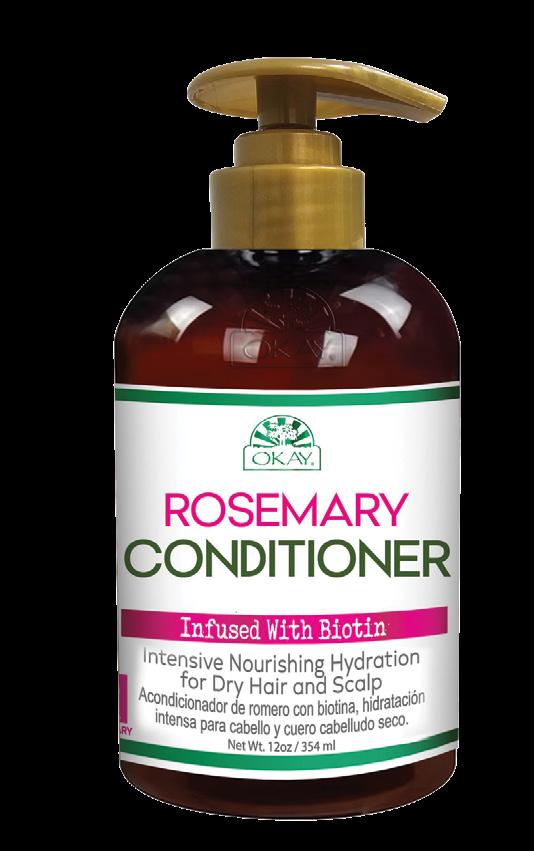
Okay Pure Naturals
“We just launched a Rejuvenating Facial Cream Cleanser that contains AHAs that help retexture, hydrate and produce glowing skin,” Dixon continued. “Our products are extremely unique in that they incorporate Halloysite, a nanotubular clay, that acts as a delivery system for key ingredients, including peptides and hyaluronic acid. They penetrate deep into the skin and are time released.”
Beyond the face, the side effects of the drugs are experienced by the entire body. “At Voesh, we see an opportunity to support this need with effective body care that includes active ingredients like peptides, caffeine and plant-based firming complexes so people can feel more confident in their bodies after significant weight loss,” said Vera Oh, founder of Voesh. The brand’s body care line includes items to brighten and smooth skin using vegan, clean and science-backed ingredients.
There are reports of hair thinning, said Juan Morillo, marketing manager at Okay Pure Naturals, prompting the need for hair growth products. “Beauty brands will likely shift their focus to helping people look and feel their best after losing weight,” he said.
Okay is ready. “For 2025, Okay is rolling out two of our biggest collections yet. The Rosemary Collection infused with biotin and the Turmeric Skincare Collection,” Morillo explained. “The Rosemary line is all about strengthening hair and supporting scalp health, combining rosemary oil and biotin to help with growth, thickness and breakage prevention.”
Keranique also offers a menu of items to strengthen hair. CVS, Ulta Beauty Target and Walmart are among the retailers


CeraVe Hydrating Mineral Sunscreen
Sheer Tint SPF 30 is now available in 3 flexible shades (Light, Medium, & Deep) that blend seamlessly with a range of skin tones.
• 100% mineral tinted sunscreen SPF 30
• Ceramides 1, 3, & 6-II
• Hyaluronic acid
• Niacinamide (vitamin B3)
AVAILABLE IN 3 FLEXIBLE SHADES
RECOMMEND AN EFFECTIVE SUNCARE REGIMEN

Explore the benefits of Hydrating Mineral Sunscreen Sheer Tint SPF 30
















offering the brand. Among the products in its toolbox are a Strengthening Leave-In Conditioner, Radiant Repair Oil and a Botanical Hair Growth System.
BosleyMD is expanding in the mass market. The medicalgrade brand now has a drug-free range sold in Ulta Beauty and Target.
“When you feel better, you want to glam it up,” said Circana’s Wyatt, noting an uptick in interest in beauty items. Lip products are especially surging as a form of hydration.
Products offering makeup and skin benefits are expected to hit the mark with consumers. Milani is expanding its Blur Out family of products, which includes Conceal + Perfect Blur Out Smoothing Primer and Conceal + Perfect Blur Out Skin Tint. The products are designed to deliver flawless, smooth skin with a blurring effect and tap into the growing demand for complexionenhancing, multifunctional products, the company said.
The business can use the lift. According to Circana, makeup was the only sector declining in mass in 2024. Retailers hope consumers feeling better about themselves will ignite a return to the makeup category.
An unexpected ripple from GLP-1 is a boost in fragrance sales. Research from NielsenIQ shows a 23% rise in perfume sales, according to Frey. When people start a GLP-1, many find that they are seeking sensory inputs that they are no longer getting from food and are turning to fragrances, she explained.
The uptick brings a much-needed boost to a mass market category that has been in a slump for more than a decade.
Dossier, Fine’ry, Mix:Bar and Being Frenshe are among the fragrance lines attracting consumers. The popularity of dupes (copies of pricey fragrances) is also bringing customers to mass market doors.
The link between fragrance and mood will become more critical, and the next fragrance a consumer buys could do more than smell good, according to Karen Young, founder of the Young Group, adding that the scent can help with everything from stress to getting better sleep. dsn

At Edgewell, we strive to add joy to the everyday by infusing the per fect blend of pa ssion, innovation and individualit y into all of our personal care brands. We’re committed making extraordinary products that are not only fun to use, but also better for both our customers and our planet .
We make useful thing s joyful.
Supermarket pharmacies are doubling down on healthcare access and food-as-medicine initiatives
By Julie Gallagher

Supermarket pharmacies are throwing a lifeline to the record number of Americans struggling to access healthcare in the form of mobile health clinics, free immunizations and pay-over-time prescription programs.
Many are also leveraging their vast food selection and nutritional expertise to provide one-on-one guidance from dietitians that allow patients to consider food as medicine and stretch their grocery budgets while maximizing nutrition.
These services come at a time when 11% of U.S. adults indicate having recently been unable to afford or access quality healthcare, show the findings of the new West-Health Gallup Healthcare Indices Study.
Since 2021, the percentage of Americans classified by the study as cost secure—being able to readily access and afford basic healthcare and prescribed medicines—is down to a record low.
DSN asked several supermarket pharmacy executives to weigh in on how they’re enhancing healthcare accessibility and providing food-as-medicine services to consumers.
How are your supermarket pharmacies helping expand healthcare access, especially in rural or underserved communities?
Katie Thornell, director of pharmacy operations, Stop & Shop: Stop & Shop Pharmacy operates more than 200 locations across Massachusetts, Rhode Island, Connecticut, New York and New Jersey, and is continually expanding healthcare access in multiple ways. The pharmacy provides a variety of in-store services, including immunizations administered by Stop & Shop’s trained and trusted pharmacists—often at no cost with most insurance plans. Available vaccines include RSV, COVID-19, flu, hepatitis A and B, HPV, pneumonia, shingles and Tetanus.
In addition to immunizations, Stop & Shop Pharmacy offers diabetes management support, wellness events, medication therapy management and prescription fulfillment for both people and pets and savings for nearly 200 generic prescriptions. Committed to reaching underserved communities, Stop & Shop Pharmacy’s pharmacists travel to under-resourced communities





to provide free immunization clinics. Through its partnership with Stop & Shop’s School Food Pantry Program, the pharmacy helps expand healthcare access at local schools. The School Food Pantry Program was created to remove barriers to student success by ensuring consistent access to food. Stop & Shop collaborates with schools from Pre-K through college to support or establish food pantries, providing gift card donations to help stock their shelves.
In 2024, Stop & Shop pharmacists conducted nine free immunization clinics for COVID-19 and flu at Title I schools in underserved neighborhoods across New York City, New Jersey and Rhode Island. These clinics provided 314 vaccines to 282 patients at no cost. In addition to schools, its pharmacists hold immunization clinics and wellness events at retirement homes, Boys & Girls Clubs, food banks, places of worship, and other social service organizations.
Anthony DalPonte, president of pharmacy and health, Albertsons Companies: Albertsons Companies pharmacies play a pivotal role in expanding healthcare access to support the health and well-being of the communities we serve. We are committed to investing in initiatives that bridge the gap between rural or underserved communities and essential food, medicine and healthcare services.
One of our key efforts includes the deployment of mobile wellness clinics. Our team of licensed pharmacists and trained technicians help provide a range of services at most locations, including diagnostic testing for A1C, cholesterol and blood glucose, as well as immunizations for adults and children, such as COVID-19, influenza, shingles, pneumonia and tetanus. Designed to be flexible, these mobile clinics offer services at convenient times, including evenings and weekends, to ensure maximum accessibility.
Additionally, many Albertsons Cos. pharmacies offer regular food and prescription delivery services to help overcome transportation barriers that many residents in rural areas face. This service ensures that community members can maintain their health regimen.
We provide specialized care at most locations for mental health and recovery through long-acting injectables, which help improve treatment adherence and reduce the risk of relapse. Patients also have access to a patient care coordinator at many pharmacies
to assist with prescription adherence, co-pay assistance and prescription delivery.
Angie Nelson, senior vice president, pharmacy, Hy-Vee: By nature, our Midwestern footprint of where our stores are located often make our pharmacists the nearest health care provider in many rural communities. Our pharmacists and dietitians embrace their role as trusted health care professionals and are committed to building long-lasting relationships with the individuals and communities they serve.
To increase health care access and reach more patients, we’ve invested in tools like virtual dietitian services and expanded pharmacy offerings to make it easier for individuals to get things like immunizations, biometric screenings, nutritional counseling and over-the-counter medication recommendations. We also deliver health and wellness services into the community using our mobile health units.
Additionally, we understand that health care costs can pose barriers to patients seeking care. We recently partnered with GoodRx and Affirm to offer a “buy now, pay over time” payment option on prescriptions to reduce upfront costs on patients. Patients who select this payment method can now have their prescriptions filled at their local Hy-Vee Pharmacy.
Bill Shinton, vice president, health and wellness, Kroger: Kroger Health is dedicated to expanding healthcare access, particularly in rural and underserved communities, through a variety of initiatives. Our Kroger Family of Pharmacies participate in the 340B program, offering outpatient medications at reduced rates. Beyond our pharmacies, we provide care through The Little Clinics in eight states and telehealth services in nine states, ensuring patients have flexible and affordable healthcare options. Our clinics accept most Medicaid, Medicare and insurance plans, making quality care more accessible.
Continue to full story online



Consumers value efficacy, innovation and convenience when it comes to eye- and ear-care
By Kathie Canning

Whether they’re suffering from red, itchy eyes during allergy season, dealing with the discomfort of ear wax buildup or living with another eye- or ear-health threat, many consumers look to over-the-counter products for relief. Drug stores that focus on efficacy and ontrend innovation could drive growth in these categories.
On the eye care front, there is “growing consumer awareness” of the importance of preventive care in eye health, noted Scott Berg, general manager, consumer eye care for North Chicagobased AbbVie. That reality is impacting the OTC eye drop category.
“With increased screen time and an aging population, there is a rising demand for products that address digital eye strain, dry eyes and other age-related conditions,” he said. “Reduced blinking from prolonged device use contributes to eye surface dryness, making consistent, everyday eye care a top concern rather than just a seasonal issue tied to allergies or indoor air.”
John Ferris, president, consumer division at Bausch + Lomb, Bridgewater, N.J., agreed that dry eyes are a major eye-care concern. The condition impacts more than half of the U.S. population, he noted, citing a 2021 study from Princeton, N.J.based Multi-sponsor Surveys Inc.
Contact lens care also is a major concern on the eye-health side. Many contact lens wearers don’t care for their contact
“With increased screen time and an aging population, there is a rising demand for products that address digital eye strain, dry eyes and other age-related conditions.”
—Scott Berg, general manager, consumer eye care, AbbVie
lenses properly, Ferris noted, which puts them at risk for eye infections and other issues. Bausch + Lomb works with retailers to provide educational materials and programs that help steer these consumers to the appropriate eye-care products and raise awareness of the preventive steps recommended to improve their eye health.
It also worth noting that today’s consumers increasingly are seeking out “personalized treatment approaches” for the treatment of eye-health issues, Berg stressed. Those approaches fit seamlessly into individual lifestyles and consider factors such as environmental exposure and digital device usage.
Commanding the most attention in the ear-care category, meanwhile, are OTC hearing aids. But these relatively new


















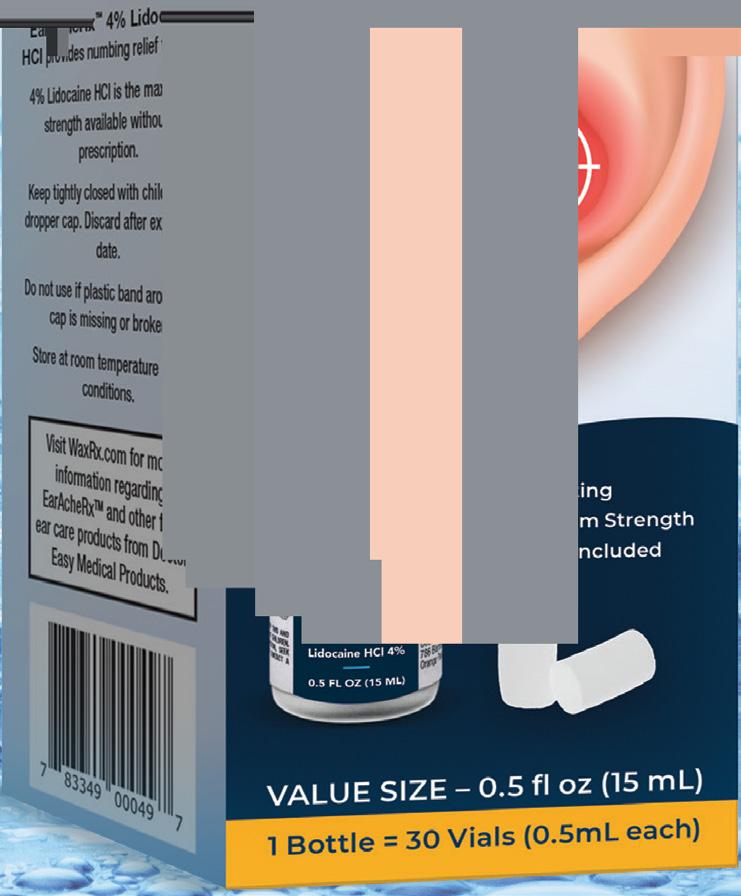































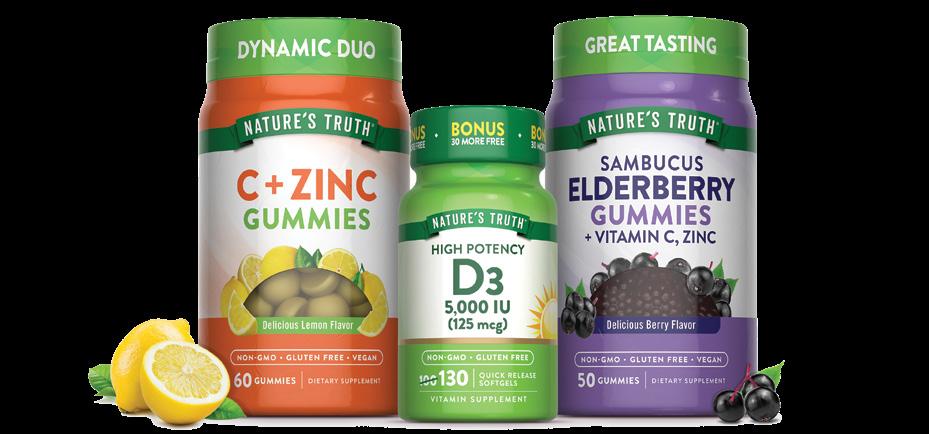
properties. Launched in 2014, Beekeeper’s Naturals is among key players, offering throat sprays, lozenges, oral supplements and other products.
This past summer, it added Throat Soothing Lollipops and Throat Spray for kids. Lollipops have only 2 g of sugar and no artificial dyes or flavors. Flavors include strawberry, green apple, mixed berry with elderberry and watermelon. This combination of formats and ingredients have caused products to dominate the children’s market.
“Innovation is in this Beekeeper’s item,” said David Levy, director of sales, Childlife Essentials. “They clearly hit on something with the lollipop, and it’s driving the category, followed by throat spray.” At Childlife, top sellers include echinacea, liquid vitamin C, D3 drops, zinc and probiotics with colostrum (chewable tablets), he added.
Lifelab is also buzzing around the hive. Earlier this year, it expanded its HoneyWorks brand of organic honey cough syrups and throat sprays with HoneyWorks Plus. The “Plus” includes dextromethorphan, a decongestant and doxylamine succinate, which works somewhat like melatonin, said Machin. Products are available in day and nighttime formulations, with separate children’s and adults’ items.
“Moms want clean products with natural ingredients,” he added. “It tastes amazing. Some other stuff that’s come out doesn’t taste good.” Machin noted that HoneyWorks Plus is in 700 Walgreens locations.
Mushrooms are another growing trend. Depending on the strain, mushrooms are believed to have numerous benefits, ranging from improving memory to decreasing cancer risks. Introduced in natural products channels, they are making their way into big box retailers. “Mushrooms weren’t around five to seven years ago,” said Tacl. “It’s a new subcategory. Mushrooms are like probiotics in that every strain is different.”
Last year, Mason launched Mushroom Power, a plantbased supplement made with Shiitake, Maitake and Reishi mushrooms. Shiitake mushrooms are rich in amino acids and contain anti-inflammatory properties. Maitake mushrooms are adaptogens, helping the body adapt to physical, chemical and biological stresses. Reishi mushrooms can provide a potent immunity boost. Products also contain EGCG and Matcha.
It has been five years since the COVID-19 pandemic began. Despite the sales decline, experts believe the pandemic has had a lasting impact on consumers’ thirst for immune supplement knowledge, with many shoppers continuing to seek new information.
“COVID brought a lot of education and made consumers really look at lifestyle choices that can lead to getting sick,” said Mike Frink, VP of business development, APAX. “This drastically changed how consumers view prevention and products to support their immune systems. We also have seen a focus on overall wellness and health rather than just immunity.”
To meet the needs of a better educated consumer and competitive market, APAX has “drilled down” on product quality, seeking “best-in-class” ingredients backed by studies yielding proven results, he added. “Most ingredients haven’t changed much, but we try to focus on absorption and ways to make products superior to competitors.”
Companies have also intensified social media efforts. “Social media and digital marketing have played a pivotal role in shaping consumer behavior, with influencers, medical experts and brands leveraging platforms like TikTok and Instagram to highlight the importance of immune health,” said Tina Dobush, VP marketing and communications, Piping Rock. “Engaging content, from expert-backed insights to viral wellness trends, has amplified awareness and driven demand. Additionally, the food and beverage industry’s focus on functional ingredients has further reinforced connections between diet and immunity, encouraging a more holistic approach to wellness.”
Frink is seeing more social media content from “trusted and qualified sources” that better empower consumers to take better control of their health. He added, “social media and podcasts are also providing education that’s easier to process than it was three to five years ago.”
Looking ahead, experts are con cerned about ongoing inflation and proposed tariffs im pacting shopper spending. “Part of it is economics,” said Levy. “These are expensive products. Grocery baskets cost a lot more. People are making decisions as to what to buy.”
Frink believes supplements have been less affected by infla tion than groceries.

“We haven’t seen the drastic changes the food sector has,” he said. “We know supplements aren’t always a necessity in consumers’ lives. We’ve absorbed some cost increases. We’ve tried to work smarter and streamline consumer access. Consumers can still enjoy products’ benefits without paying more.” dsn

Cautious consumers are still buying candy, including fun, innovative treats
By Nora Caley

Inflation affects consumer spending, but people still want an occasional treat. From nostalgic favorites to the trendiest flavors, shoppers buy candy, even though they try to spend less. Manufacturers say they offer new products, various pack sizes and buzzy formats to ensure they provide the right treats to fit any budget. According to the National Confectioners Association’s State of Treating 2025 report, 30% of consumers said they were treating themselves a little less, and 80% of that group said price was the reason for consuming less candy. In fact, price is now the number one decision factor, a change from previous years, when mood was the top factor.
NCA, citing figures from Circana, noted that for the 52 weeks ending December 29, 2024, confectionery sales in all outlets reached $38.6 billion. Dollar sales increased, while unit sales decreased, and non-chocolate candy outperformed chocolate. The report also noted that consumers are seeking value in different channels such as dollar stores and looking for promotions such as BOGOs and mix and match discounts.
“ We want to meet consumers where they are and this means offering quality products that best fit their needs.”
– Mike Gilroy, vice president of trade development and sponsorship at Mars Wrigley
Brands are adapting their products to appeal to these changing consumers. “We want to meet consumers where they are and this means offering quality products that best fit their needs,” said Mike Gilroy, vice president of trade development and sponsorship at Mars Wrigley. “An example of this is making available different formats that fit different snacking occasions—from single sizes for on-the-go consumption to sharing sizes for social occasions with friends and family.”
Seasonal promotions, which observers like to note are starting earlier each year, are a response to consumer demand. “Shoppers look forward to these seasonal products because of the sense of joy, comfort and nostalgia they bring,” Gilroy said. “We’re seeing seasonal windows extending and consumers maximizing seasonal joy with activities and rituals that take place across the weeks before and after holidays.”
Citing Mars research, Gilroy said Gen Z and millennials plan for Halloween nearly seven weeks in advance. “We’ve seen even more excitement around moments like Halfway to Halloween and Summerween,” Gilroy said, referring to a social mediainspired trend of celebrating Halloween in July and October. The Mars Tricks, Treats and Trends 2024 report also found that Gen X prepares for Halloween more than five weeks ahead of time.
Although NCA reports that Winter holidays, Valentine’s Day, Easter and Halloween account for 64% of candy sales, retailers can entice shoppers to buy candy year-round. “Attractive and engaging promotions, such as CVS’s Buy 1 Get 1 for $1 during seasons or Walgreens’ Treat of the Week offers, have driven great value and takeaway,” said Harry Hutson, director, drug channel for The Hershey Company.

Value is not the only sales driver, as candy is a category that thrives on fun new product launches. Hutson said the trendy innovations in sugar confections are in flavors and forms, and peelable, ropes and oversized pieces have all resonated with shoppers. The Hershey Company’s recent launches include Reese’s Chocolate Lava Big Cup, available in standard, king and snack sizes. Last year the company partnered with Shaquille
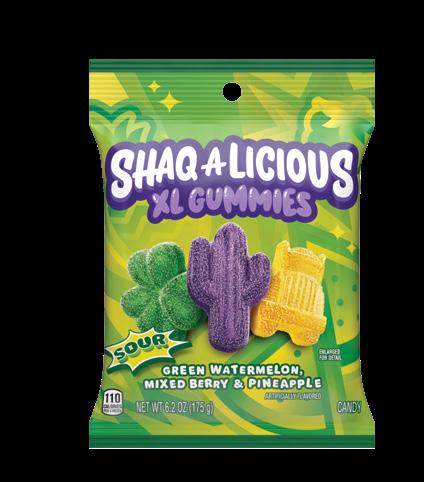
O’Neal to launch Shaq-A-Licious XL Gummies, available in both peg and pouch packs. Innovations in the Jolly Rancher line include Jolly Rancher Ropes and Jolly Rancher Freeze Dried, both of which are new forms for the brand.
Freeze dried candy, another trend on social media, features concentrated flavors and a crunchy texture. The format is among several that are a big hit among young adults. “Generation Z consumers are drawn to different textures, like gummies, and fruity and sour flavors,” said Gilroy, from Mars Wrigley. New products include Skittles Pop’d Freeze Dried Candy in Original and Sour.
Nostalgia also inspires new products. Mars Wrigley added Peanut Butter & Jelly to the M&M’S Peanut Butter portfolio, with berry flavored bite-sized chocolate treats and a peanut butter center to suggest the sandwich. “We know that consumers are looking for more experiences from products, and new ways to enjoy them,” Gilroy said. In Snickers, new products include shapes such as Halloween pumpkins and Winter Holiday trees, and Snickers Pecan, which has caramel, nougat, milk chocolate and pecans.
NCA’s State of Treating Report also noted that 62% of consumers believe better-for-you options are available, such as dark chocolate, organic items or no artificial ingredients.
Smart Life Chocolate makes Dark Chocolate with Probiotics, which are good for gut health, and Dark Chocolate with Cocoa
Flavanols, with antioxidants to help fight inflammation and free radicals. Both are 70% cacao.
Company founder Barry Gasaway said the products are a good fit for retailers that have health as part of their messaging. “A lot of science based experiments and studies have been done that are now starting to bring awareness on how good dark chocolate is for you,” he said. “It’s for people looking to enjoy chocolate with a purpose.” dsn
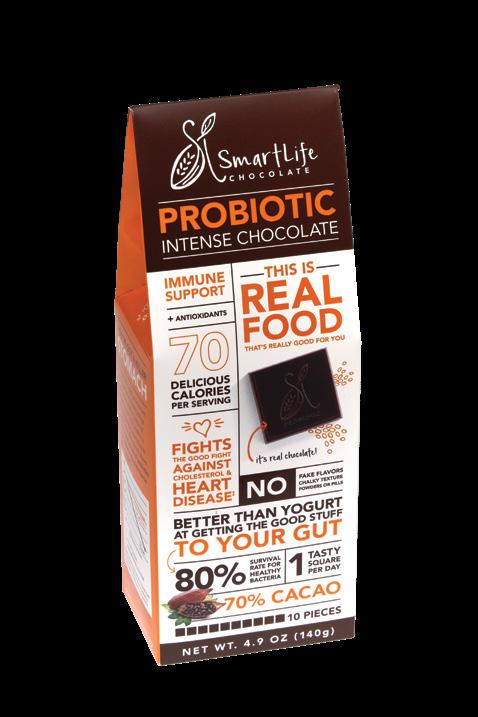
By David Orgel

This is a unique time for online shopping. Grocery and drug store retailers are pursuing distinct strategies as they work to improve customer experiences. Their efforts vary from high tech to low tech and from food aisles to pharmacies. The stakes are high because e-commerce is on a growth path. Consider that total U.S. online sales for grocery items are projected to reach $388 billion by 2027, according to the 2025 report called Digital Engagement Transforms Grocery, from FMI—The Food Industry Association—and NielsenIQ. The online share currently represents about a fifth of total omni sales, but the online portion is growing faster than in-store, the report found.
Here is a small sampling of the ways retailers are trying to improve e-commerce.
• High-Tech: Walmart recently struck a deal with AI-enabled solutions company Symbotic that will help the retailer develop, build and deploy an advanced robotics platform solution to accelerate online pickup and delivery.
• Low-Tech: Whole Foods Market entered a partnership to install protective canopies above customer vehicles at curbside pickup locations in a number of states. The move will make pickup experiences more
David Orgel is an award-winning business journalist, industry expert and speaker. He is currently the principal of David Orgel Consulting, delivering strategic content and counsel to the food, retail and CPG industries.
Shoppers are getting pickier as they try different e-commerce platforms over time.
A study earlier this year by The Feedback Group found that supermarkets lead in online grocery satisfaction, demonstrating strong execution in convenience, fulfillment and service.
pleasant and less subject to impacts from weather.
• Delivery: Midwest retailer Meijer expanded its home delivery service area, tripling its range from an approximate 20-minute radius from its stores to 60 minutes.
• Fulfillment: Texas retailer H-E-B added to its portfolio of e-commerce fulfillment centers by opening a third in Houston—a 100,000-sq.-foot facility—which becomes the ninth unveiled in Texas since 2018.
New Approaches Benefit Pharmacy
Pharmacy is a beneficiary of the latest e-commerce moves. CVS Health launched a new app that aims to ease customer health and pharmacy needs with the ability to manage prescriptions through convenient delivery and fulfillment options. The app’s features include enhanced, AI-powered search that helps consumers locate products, services and information.
Meanwhile, Walmart has expanded its same-day pharmacy delivery to customers across 49 states. Same-day pharmacy orders can now be integrated with general merchandise and grocery orders, benefitting from advanced technology that includes in-store and cloud-based tech platforms and AI programs.
Retailers will do well by seeking customer input about their e-commerce needs. As a case in point, Wegmans Food Markets was reportedly researching customer preferences as it worked on developing an improved e-commerce app. Some Wegmans customers reportedly received an invite via email to participate in beta testing of the app—in particular its search and list-building features. I can’t think of a better way to assess functionality than by going right to the customer base.
As retailers strive to boost customer experience, they also need to overcome profitability challenges involved with e-commerce. For example, grocers point to picking and fulfilment expenses as key hurdles to profitability. Many grocers plan to invest in fulfillment platforms to automate picking, packing and last-mile delivery, according to Grocery Doppio. Another imperative is to ensure that ecommerce does not exist on an island by itself.
The previously mentioned FMI/NielsenIQ report found that more than 90% of shoppers participate in both online and in-store shopping. This indicates that retailers should focus on omnichannel strategies to ensure shoppers are satisfied no matter how they engage with the retailer. That’s a great approach to cover all the bases. dsn
For veterans living with PTSD, service dogs can provide a lifeline.
By Joe Toscano, Vice President, Trade & Industry Development at Purina
The statistics are sobering: up to 30% of military veterans live with Post-Traumatic Stress Disorder (PTSD), yet only a fraction have access to the life-changing support of a trained service dog. With service dog training costs reaching upwards of $25,000 per dog and wait times often exceeding 18 months, many of our veterans are left without this vital resource that could help them reclaim their lives.
That’s why Purina Dog Chow created the Service Dog Salute program in 2018, which has contributed approximately $1.4 million to veteran service dog training organizations since its founding, and more than 30 grants to 501c3 service dog organizations. Our initiative helps fund the intensive training required to prepare these exceptional animals to support veterans living with PTSD. The impact of a service dog on a veteran’s life cannot be overstated. These highly-trained companions can recognize signs of anxiety or distress, provide calming pressure during stressful situations, and help veterans navigate daily challenges with greater confidence. Many veterans report significant improvements in their quality of life, relationships, and ability to participate in community activities after being paired with a service dog.
“I started getting better,” U.S. veteran Jonathan Lucas describes

of his service dog, Savannah. “I’m no longer hiding from society. I can go back to concerts. I can be around crowds. And [Savannah] brought me to this point, where I can be around all environments. She brought me back to the world.”
Our commitment to this cause runs deep. Beyond our financial contributions, we’ve launched nationwide awareness campaigns, partnered with veteran advocacy groups, and worked closely with service dog training organizations to understand and address the challenges they face.
Jonathan and Savannah’s story and more were recently featured in the 2024 New York Dog Film Festival, as part of the Dog Chow Service Dog Salute category’s winning film, A Dog Can Make a Difference.

For retailers, supporting the Service Dog Salute program represents both a business opportunity and a chance to make a meaningful difference. Our dedicated merchandise units create compelling in-store displays that resonate with shoppers. More importantly, by featuring Service Dog Salute displays, retailers help raise awareness about the critical need for service dogs among our veteran community.
To learn more about how you can support the Service Dog Salute program, contact your Purina sales representative. Together, we can help provide more veterans with the life-changing support of a trained service dog while driving category growth in your pet food aisle.